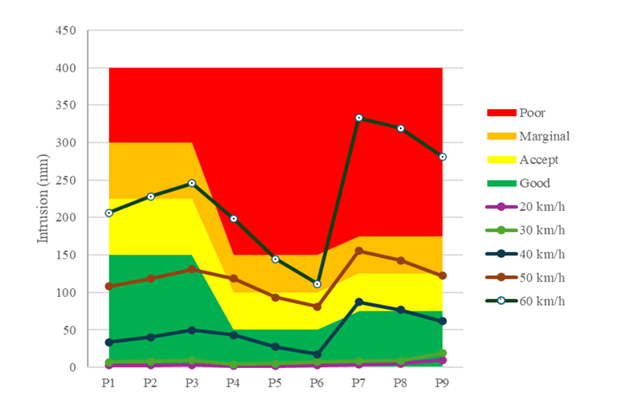Following the numerical modeling in the first phase, this study presents an in-depth simulation analysis of a sedan’s structural response under rear-end chain collisions involving two heavy-duty trucks. The simulation aims to quantify how collision speed, energy distribution, and structural deformation interact to affect the safety of vehicle occupants.
Kinetic and Internal Energy Behaviour
The Finite Element Method (FEM) simulation was performed for impact velocities ranging from 20 km/h to 60 km/h, representing typical crash speeds in dense traffic.
Results show that:
- At 20 km/h, the system’s initial kinetic energy was 0.592 MJ, while at 60 km/h, it reached 6.26 MJ, marking a tenfold increase.
- Within the first 0.2 seconds post-impact, kinetic energy rapidly transformed into internal energy, absorbed through material deformation and crumple zones.
- The internal energy reached 418 kJ at 60 km/h, indicating significant structural stress beyond the vehicle’s designed absorption capacity.
This highlights that as impact velocity increases, the sedan’s body structure can no longer dissipate crash energy efficiently, leading to severe cabin intrusion.
Displacement and Intrusion Analysis
The simulation recorded a maximum displacement of 1,763 mm at 60 km/h, compared to 542 mm at 20 km/h, showing the proportional relationship between impact energy and structural collapse.
Intrusion analysis based on IIHS standards revealed critical safety concerns:
- At 40 km/h, energy absorption in the trunk reached its limit, and deformation began transferring toward the passenger compartment.
- At 60 km/h, upper hinge pillar intrusion exceeded 330 mm, breaching the safety threshold for survival space.
- In contrast, the rocker panel zone maintained better integrity, showing minimal intrusion values.
These findings demonstrate that even moderate-speed chain collisions can cause severe cabin deformation, emphasizing the urgent need for reinforced passenger structures and intelligent crash energy management systems.
 Figure 1: Intrusion data at the critical points with severity rating (poor, marginal, acceptable and good) for various impact speeds
Figure 1: Intrusion data at the critical points with severity rating (poor, marginal, acceptable and good) for various impact speeds
Practical Implications and Engineering Recommendations
The results underscore the importance of rear-end crash protection in sedan design, particularly in regions with high truck density. The following engineering directions are recommended:
- Reinforcement of upper hinge pillars and rear frames using high-strength steel or composite reinforcements.
- Integration of energy-absorbing materials such as aluminium foams or topologically optimized titanium alloys to enhance Specific Energy Absorption (SEA).
- Implementation of sensor-based collision mitigation systems, including automatic braking and collision warning units, to prevent secondary impacts.
Beyond design optimization, policy interventions are also crucial — such as enforcing truck speed limits in urban zones and updating vehicle safety regulations to include multi-impact scenarios.
Conclusion
This study offers valuable insights into the crashworthiness performance of sedan vehicles under complex multi-vehicle collision conditions. The findings demonstrate that a chain impact at just 40–60 km/h can exceed the structural resilience limits of standard passenger cars, resulting in catastrophic intrusion.